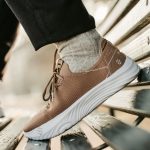Frequently Asked Questions – SPINE Footwear
1. How Does SPINE Footwear Work?
SPINE footwear is designed to help improve posture and reduce tension in the lower back by promoting a more natural alignment of the spine. The spine has natural curvatures in the neck, torso, and lower back, and when the lower part of the spine curves too far inward, the condition is called lordosis.
SPINE footwear features a unique design with inverted drop soles that slightly elevate the front of the foot, creating a natural bend in the knees and reducing pelvic tilt to restore a natural centre of gravity. This can instantly correct lordosis, reducing tension in the lower back and creating a strong, neutral spine, also known as good posture.
2. Are Inverted Drop (Negative Heel) Footwear Good For Lower Back Pain?
Lower back pain is a term that encompasses a wide range of different diagnoses. If you suffer from lower back pain, you should be evaluated by a specialised healthcare professional in order to have a proper diagnosis and a good treatment plan that might include negative heel shoes that work by promoting a posteriorisation of your centre of mass, diminishing the strain in the lumbar structures.
3. How Does The Inverted Drop (Negative Heel) Work?
A negative heel (Inverted drop) raises the toe above the heel, this adjusts the body’s centre of gravity backwards. This reduces the tendency for hyperextending the knees and reduces the curvature of the lower spine, reducing tensions in the low back structure.
4. How Does Footwear Affect Posture?
Conventional footwear, those with heels or flat soles can contribute to a poor posture. For example, high heels move your centre of gravity forward, forcing the body to compensate by leaning backwards. This leads to an increased curvature of the lower spine, leading to great tension in the structure in this area.
5. Does SPINE Footwear Help With Aching Legs?
Inverted drop footwear stretches the calf muscle. As a result, the veins of your legs are squeezed, lowering inflammation (peripheral venous stasis) responsible for the common sensation of “tired legs”. Our clinical studies show that using our shoes in a standing position increases the venous return by 95%.
6. Does SPINE Footwear Provide Pain Relief From Sciatica?
Sciatica is a subtype of lumbar back pain. it’s specific and has a lot of variants (depending on which structure is being compressed, the grade of compression, if the nerve is functioning well in motor and sensitive terms…). We suggest seeing a qualified physician to assess your medical needs.
7. Can SPINE Footwear Help Treat Lumbar Lordosis?
SPINE shoes are designed to provide support and cushioning to the foot and may help improve overall posture and comfort. However, it is important to note that lumbar lordosis is a complex condition that involves an excessive curvature of the lower spine, and it typically requires a comprehensive treatment plan that may include physical therapy and other interventions.
While wearing SPINE shoes may help relieve some of the discomfort associated with lumbar lordosis by improving overall posture and reducing pressure on the lower back, they are not specifically designed to treat the underlying condition. It is important to consult with a healthcare professional for a proper diagnosis and to develop a treatment plan that is tailored to your individual needs.
8. Can SPINE Footwear Help Promote A Neutral Spine?
The negative heel design of SPINE shoes can help promote a more natural posture by aligning the spine, pelvis, and legs, and reducing pressure on the lower back. When the foot is slightly elevated at the heel, it can help shift the body’s weight forward and promote an upright posture, which can help reduce strain on the lower back and improve overall spinal alignment.
9. I’m Pregnant, Will SPINE Footwear Help Relieve Lower Back Pain?
Pregnancy can cause lower back pain and discomfort due to the additional weight and changes in posture as the body adjusts to accommodate the growing foetus. SPINE shoes can be a useful tool in relieving lower back stress during pregnancy by promoting good posture and reducing pressure on the lower back.
The unique design of SPINE shoes, with the negative heel and supportive cushioning, can help distribute weight evenly across the foot, reduce over-pronation or supination, and promote a more neutral posture. This can help reduce the strain on the lower back and provide relief from pain and discomfort.
However, it is important to note that every pregnancy is different, and some women may require additional support or intervention to manage their lower back pain. It is important to consult with a healthcare professional for advice on the best approach to managing your lower back pain during pregnancy.
10. Will SPINE Footwear Correct My Posture?
The negative drop design of SPINE shoes can help reduce the pressure on the lower back and encourage a more upright posture. This can also help reduce the risk of developing poor posture habits and associated back and neck pain.
In addition to the negative drop design, SPINE shoes also provide support and cushioning to the foot, which can help distribute weight evenly and reduce the risk of overpronation or supination. This can also help promote a more natural posture and reduce stress on the lower back.
While wearing SPINE shoes can be a useful tool in promoting good posture and a more neutral spine, it is important to remember that they are not a substitute for an overall healthy lifestyle that includes regular exercise, stretching, and maintaining proper posture throughout the day.
11. How Do Orthopaedic Shoes Help Posture?
Orthopaedic shoes are designed to provide support and stability to the feet, which can have a positive effect on posture. By providing a stable base for the feet, orthopaedic shoes can help distribute weight evenly across the foot, reduce overpronation or supination, and promote a more natural gait.
When the feet are properly supported, it can help reduce the stress on the joints of the foot, ankle, knee, hip, and lower back. This can also help reduce the risk of developing poor posture habits, such as slouching or leaning forward, which can put additional strain on the muscles and ligaments of the back and neck.
Orthopaedic shoes can also help improve balance and stability, which can be particularly beneficial for individuals with conditions that affect their balance, such as Parkinson’s disease or multiple sclerosis.
12. Achilles Tendon – What’s The Effect Of Spine Shoes On Plantar Fasciitis And Achilles Tendinopathy?
Strengthening and stretching the Achilles tendon and Plantar fascia are the mainstream of any rehabilitation program that addresses these pathologies. Spine shoes both stretches the Achilles tendon and plantar fascia and strengthens the calf and intrinsic muscles of the foot. If you have any of these pathologies ask your medical provider how you can integrate Spine shoes in your treatment program.
13. Arch Support – Why Don’t Spine Shoes Have Arch Support?
There is a really wide range of arch anatomy, from flat to cavus feet so it’s really difficult to have a standard arch support that works for every feet. Furthermore, arch supports weaken the intrinsic muscles of your feet by supporting/impairing the natural movement of the foot. Spine shoes follow a completely different approach, increasing the motion of your ankle and strengthening the intrinsic muscles of your foot, thereby providing you a naturally formed arch.
14. Insole – Can I Use My Customized Insoles With Spine Shoes?
The molds of customized insoles are generally taken with the foot in zero degrees of dorsiflexion. Consequently your customized insoles may hurt your feet when you use them in your Spine shoes. If you have any foot condition that requires the use of insoles ask your pedologist how you can adapt them.
15. Knee – What’s The Effect Of Spine Shoes In My Knee?
The sagittal imbalances more frequently affect the spine and the coronal imbalances more frequently affect the knee. Spine shoes modulate imbalances in the sagittal plane, thereby affecting mostly the spine and not the knee. We haven’t run any experimental study on knee pathology yet, but we have several case reports of users improving their knee symptoms. A theoretical hypothesis for this is that when a foot touches the ground in dorsiflexion, you control the pronation of the foot, which is a well-known mechanism of knee overload.
16. Lower Back Pain – Since We Start Using Spine Shoes, How Long Does It Take To Be Pain Free From My Lower Back?
Lower back pain is a complex symptom of varied causes and severities. A common treatment approach is to try to control the symptoms by the least invasive way, starting with physiotherapy and medication and scaling up to injections and surgeries if the first steps aren’t enough. Spine shoes is a simple and non-invasive tool that helps decrease hyperlordosis that is associated with vertebral instability. Our studies show that using Spine shoes decrease the lumbar lordosis in 19%, diminishing the load imbalances between the anterior and posterior aspects of the vertebrae and disks. If you have lower back pain ask your medical provider about how you can use Spine shoes in your treatment program.
17. Metatarse – Are Spine Shoes Good For My Hallux Valgus, Morton’s Neuroma Or Metatarsophalangeal Pain?
Normal drop shoes increase the pressure in the front of the foot, overloading the metatarsophalangeal joints. The Spine Shoes inverted drop decreases the load in the anterior structures of the foot that are affected in both this pathologies. Furthermore, Spine shoe’s toe box is wide, respecting the anatomy of your toes, so they may splay naturally.
18. Sports Recovery – Are Spine Shoes Adequate For Sport’s Recovery?
There are several recovery aids that can be used after sports. One of the main tools are compression garments that improve the peripheral venous blood return, theoretically draining all the metabolites that are accumulated during exercise. Our studies showed a peripheral venous blood return that is higher than the one provided by compression garments, without the need of using tight clothing.
19. Urinary Incontinence – What’s The Effect Of Spine Shoes In Urinary Incontinence And Core Activation?
There are several studies and even a meta-analysis that show that ankle dorsiflexion improves the activation of the pelvic floor muscles, being advised to do pelvic floor rehabilitation exercises with the ankles in dorsiflexion. Spine shoes dorsiflex your ankles all day, improving the activation of these relevant muscles. Furthermore, our studies showed an improvement in 8% in core muscle activation, thereby controlling the tendency to “rounded belly.”
20. Venous Return – How Do Spine Shoes Promote Peripheral Venous Return?
When we are standing, a great part of our pool of venous blood is staying on our lower legs, in a rich venous plexus that crosses the calf muscles. More venous peripheral blood means more foot edema and “tired legs” sensation in the end of the day. Spine shoes stretch the calf muscles and increase their activation while walking, thereby diminishing this pool of peripheral venous blood. Our studies showed an increase of 71% of the blood flow in the vein in the back of the knee (Popliteal vein), measured by ultrasound. If you have a peripheral venous insufficiency, ask your medical provider how you can integrate Spine shoes in your treatment program.




